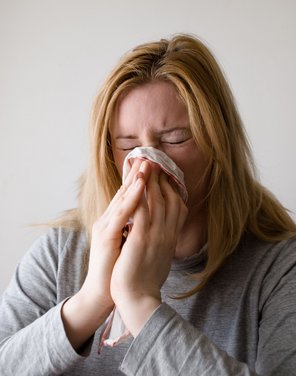GUIDE FOR CLEAR RESPIRATORY TRACTS
Acute and recurrent sinusitis – differences, symptoms, treatment
A cold with rhinitis can frequently lead to acute sinusitis. Every winter millions of people in Germany are affected by sinusitis. Sinusitis is inflammation of the mucous membranes in the sinuses, which is usually preceded by inflammation of the nasal mucosa, i.e. rhinitis. It may be caused by viruses, bacteria or an allergy.
Swelling of the nasal mucosa due to inflammation blocks the openings to the nasal sinuses. This results in insufficient air flow through the sinuses and greatly inhibits the drainage of secretions. If secretions accumulate in the sinuses, viruses and bacteria can proliferate and trigger an infection. A typical symptom is strong pressure pain that becomes worse when you bend over. The correct term is actually rhinosinusitis, as sinusitis is generally accompanied by rhinitis.
Here you will find information about these topics
What causes sinusitis?
There are usually several factors that lead to sinusitis
Colds are common, especially during winter. When our mucous membranes are dried out and our immune system is weakened, these are the perfect conditions for a viral or bacterial infection. Viruses and bacteria adhere to our nasal mucosa, where they proliferate and cause inflammation. This can result in swelling of the mucosa and constriction of the openings to the sinuses. Consequently, there is insufficient air flow and the drainage of secretions is inhibited. The secretions that accumulate provide a good breeding ground for pathogens, which then proliferate in the sinuses. They cause inflammation in the sinuses, i.e. acute sinusitis.
Viruses such as adenoviruses or rhinoviruses are commonly responsible for the initial infection; they cause a straightforward rhinitis and consequently acute sinusitis. Antibiotics cannot help in this situation, as they are only effective against bacteria. However, because the defense mechanisms of the nasal mucosa are no longer effective, a secondary infection caused by bacteria – frequently pneumococci, but also others – can occur in the sinuses.
If the bacterial infection does not resolve completely, there is a risk of recurrent sinusitis developing. Allergic rhinitis and abnormal anatomy of the sinus openings – such as a deviated nasal septum or enlarged nasal turbinates – may also cause recurrent sinusitis.
The different types of sinusitis
Sinusitis may have an
acute or recurrent
course.
In general, acute sinusitis develops on the back of a common rhinitis. However, the presence of yellowish-green mucus draining from the nose is not sufficient in itself for a diagnosis. The two main symptoms of acute sinusitis are: facial pain that increases when bending over and a feeling of pressure in the face. Sufferers describe pressure pain that can occur in the region of the cheekbones, forehead, head, eyes and teeth, i.e. in the area where the sinuses are located.
Only when the sinusitis has lasted for at least three months is it possible to speak of a recurrent course. Inflammation is still present but there is considerably less pain. If you tap the fingers gently against the sinuses, a feeling of pressure may arise. In recurrent sinusitis, pain is often absent.
The Rhinosinusitis Guideline* distinguishes between different types:
Acute sinusitis:
Symptoms last for a maximum of 12 weeks; often their duration is much shorter, i.e. 8–14 days.Recurrent acute sinusitis:
Four episodes of acute rhinosinusitis occurring within one year. In between episodes the symptoms disappear completely.Recurrent sinusitis:
Symptoms persist for longer than 12 weeks – with or without nasal polyps.
*Rhinosinusitis. S2k Guideline AWMF Register Nos. 017/049 and 053-012 from 07/04/2017, revised on 26/04/2019 https://www.awmf.org/uploads/tx_szleitlinien/017-049_und_053-012l_S2k_Rhinosinusitis_2019-04.pdf

Signs and symptoms of acute sinusitis
Typical symptoms of sinusitis are:
a “blocked” nose which impedes nose breathing
impaired sense of smell
purulent nasal discharge
facial pain, particularly when bending over – variable depending on which sinuses are affected:
feeling of pressure above the sinuses
“toothache” in the region of the upper jaw
pain on one side of the forehead
pain when bending over
Particularly in the case of allergic sinusitis the mucous membrane may produce excessive amounts of mucus, which runs down the throat. Doctors call this a post-nasal drip. The mucus irritates the throat, and sufferers must either swallow the mucus or spit it out. They also clear their throat or cough frequently and may have a hoarse voice.
If there is a viral cause for the sinusitis, the symptoms generally resolve within ten days. If bacteria are responsible for the acute sinusitis, the symptoms often intensify again after five days or last much longer than ten days in total. Fever and a severe headache may also occur. However, it is not possible to distinguish conclusively between viral and bacterial sinusitis on the basis of symptoms and duration alone. For this purpose, laboratory findings for procalcitonin (PCT), erythrocyte sedimentation rate (ESR) or C-reactive protein (CRP) can be a helpful aid. Increased levels indicate a bacterial cause for the inflammation.
If sinusitis does not have an allergic cause, it can be contagious. The pathogens that caused the sinusitis – viruses or bacteria – can be spread by droplet infection. Even having a conversation with an infected person a short distance away is enough for the infection to spread. If our immune system is effective, we are well protected against pathogens. A healthy person generally does not become infected. It is nonetheless important to practice good hygiene during cold season: frequent hand-washing and not touching your face offer a first level of protection. In addition, it makes sense to strengthen your immune defenses, for example by taking Symbioflor® 1 regularly.
Treatment of acute sinusitis
Drink plenty of fluids so that the mucous membranes are able to remove pathogens.
In the treatment of acute sinusitis, it is especially important to ventilate and empty the sinuses. Decongestant nasal drops or sprays can help ventilate the sinuses. However, they should never be used for longer than a week, as there is a risk of dependence with a chronically congested nose.
The inhalation of warm vapor over a period of several days can also alleviate the symptoms of sinusitis. The vapor can make the secretions more liquid and thus facilitate emptying of the sinuses. The temperature of the vapor should be between 38 and 42°C; it is not necessary to add essential oils. However, if you do decide to add essential oils, it must be noted that the use of menthol is not suitable for infants. Ointments containing menthol that are rubbed into the skin should also not be used on babies and infants.
Substances from the field of phytotherapy, such as Myrtol, cineole and a primrose mixture, are suitable for the treatment of acute sinusitis. The pineapple enzyme bromelain can also reduce swelling of the mucous membranes, promote ventilation of the sinuses and thereby ease symptoms. Acupuncture can also improve nose breathing in acute sinusitis and in addition alleviate pain. It is particularly effective against headaches.
Antibiotics can help in the case of bacterial sinusitis. However, as they generally also harm the beneficial bacteria, they weaken the immune system in the long term and thereby increase the risk of recurrent infections such as recurrent sinusitis. This is because the mucous membranes in humans – including the respiratory tract – is colonized by bacteria that can protect us from pathogens and strengthen the immune system. Because frequent antibiotic treatments increase the resistance of bacteria, naturopathic treatments are preferable. However, if the pain becomes significantly worse during the course of sinusitis and the body temperature rises above 38.3°C, antibiotic treatment – accompanied by pain medication – may become necessary. In severe cases it is possible for the inflammation to spread to adjacent tissue in the sinuses and cause complications. In order to reduce the negative effect of antibiotics, the consumption of lactic acid bacteria during antibiotic treatment is recommended.
There are also simple measures that can help alleviate symptoms during acute sinusitis. For example, drinking plenty of fluids makes the mucus in the respiratory tracts more liquid and facilitates emptying of the sinuses. When suffering from sinusitis you should drink three to four liters of fluid a day.
Air conditioning and warm air from heating systems dry out the mucous membranes and thereby increase susceptibility to infection. Suitable substances to maintain the mucous membranes include nasal rinses containing salt and nasal sprays or ointments – also with moisturizing additives such as dexpanthenol.
Rest and warmth are also beneficial. Warm throat and chest compresses, infrared light or a cold remedy bath can also offer relief. The bath water should not be too hot, however, and you should not bathe for longer than 20 minutes. Afterwards bed rest is the best option.
UNWELCOME PERMANENT GUEST
Signs and symptoms of recurrent sinusitis
While viruses cause acute sinusitis, bacteria, allergies or anatomical anomalies are responsible for recurrent sinusitis.
If acute bacterial sinusitis does not resolve completely, allergic swelling of the mucosa occurs or the inflammatory mechanism in the nasal mucosa is disrupted, new tissue may form in the inflamed area. If this results in a bulge in the nasal mucosa, doctors call this a polyp. The newly formed tissue can permanently impair ventilation of the nose, thereby resulting in recurrent sinusitis. However, recurrent sinusitis can also occur in the absence of nasal polyps.
In recurrent sinusitis, the symptoms are less severe than with an acute infection. However, recurrent sinusitis sufferers are less resilient and suffer from disrupted sleep and general exhaustion. In addition, they are more susceptible to all types of infection. With recurrent sinusitis the symptoms generally persist for longer than 12 weeks. Recurrent sinusitis can significantly reduce quality of life. Sinusitis places a strain on sufferers similar to that of common chronic diseases such as cardiac insufficiency, asthma and back pain. The number of individuals affected increases with age, with a predominance of women. Individuals with asthma, allergies and the lung disease COPD are especially susceptible to recurrent sinusitis.

Treatment of recurrent sinusitis
Decongestant nasal drops and sprays are appropriate for acute sinusitis. They are not suitable, however, for the treatment of recurrent sinusitis. If decongestant medications are used over a longer period, they dry out the nasal mucosa. In response, the mucous membrane swells in order to increase blood flow. This in turn makes it more difficult to breath through the nose, even though the actual infection causing the sinusitis has already resolved. This creates a vicious circle in which the sufferer uses nasal sprays more and more frequently to clear their blocked nose. Pieces of dried nasal mucus can form when the nose is dry, causing permanent damage to the nasal mucosa.
In this case, nasal rinses and nasal sprays containing saline solution (2–3.5%) are suitable to treat recurrent sinusitis. Their effect can last for up to six months. If the concentration of the saline solution is lower than 2%, however, the efficacy wears off. Inhalation of hot vapor (38–42°C) is also recommended.
Another natural means for sufferers to treat infectious recurrent sinusitis is with medical probiotics – probiotic drugs with living bacteria – such as Symbioflor® 1. The bacteria boost the body’s defenses against recurrent infection. These natural bacteria are an important element of the body’s defense system. They colonize the skin and mucous membranes and leave very little room for pathogens to proliferate.

